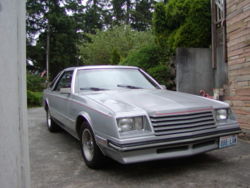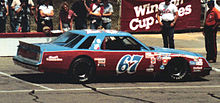- Dodge Mirada
-
Dodge Mirada 
Manufacturer Chrysler Corporation Production 1980–1983 Assembly Windsor, Ontario, Canada Predecessor Dodge Magnum Class Full-size Body style 2-door coupé Layout FR layout Platform J-body Engine 225 cu in (3.7 L) Slant 6 I6
318 cu in (5.2 L) LA V8
360 cu in (5.9 L) LA V8Transmission 3-speed A904 automatic
3-speed A727 automaticWheelbase 112.7 in (2,863 mm)[1] Length 209.5 in (5,321 mm) Width 72.7 in (1,847 mm) Height 53.3 in (1,354 mm) (1980)
53.2 in (1,351 mm) (1981–)Curb weight 3,373 lb (1,530 kg) (1980)
3,380 lb (1,533 kg) (1981–)Related Chrysler Cordoba
ImperialThe Dodge Mirada was a full-sized, rear-wheel drive coupe built from 1980–83, and was one of the three cars based on the Chrysler J platform, the other models being the second generation Chrysler Cordoba and the Imperial, these three vehicles being Chrysler's response to the downsizing of its car lines. The Mirada was 800 lb (360 kg) lighter and its wheelbase 2.3" shorter (112.7" vs 115") than the Magnum it replaced. Production numbers were low, with just under 53,000 units sold during its production run. The Mirada would stay relatively unchanged during its 4-year run, with the exception of paint colors and engines. Because of the low production and survival rate, Miradas today are garnering some limited interest from collectors, particularly models with the 5.9 liter V8.
Contents
Marketing
The Mirada was marketed as a personal luxury car, an extremely popular segment at the time. Advertising and marketing were limited, as the car was introduced when Chrysler was in deep financial difficulty.
NASCAR
It was hoped that the Mirada would reopen the door to Dodge success in NASCAR racing, as the nameplate had not won a race since November 1977. Lee Iaccoca personally called Richard Petty in late December 1980, asking the King to campaign one, with the promise of parts needed to build the cars and engines. Several teams, most notably Petty and Junior Johnson, built race ready test cars and to took them to race tracks for testing. The Petty built test Mirada looked every bit as fast (Petty himself remarked "The Mirada just looked good!") as the other race cars eligible to run in competition. On 17 January 1981 at Daytona (Petty fans were so enthusiastic he was running a Dodge again that 15,000 or so showed up to watch), the testing showed the car was around 8 mph (13 km/h) slower than the GM and Ford cars of the day, and Petty and the most of other drivers moved to other makes, mostly GM.[2] This testing of the car revealed that while it looked fairly aerodynamic, the bodystyle actually had a very high coeficient of drag that made it incapable of speeds over 185 mph. Petty's and Daryl Waltrip's (driving the Junior Johnson built Mirada race car) test results turned out to be a huge disappointment to Dodge, and took the wind out Chrysler's efforts to re-establish itself in racing. Two small and independent racing teams (Arrington Racing/Buddy Arrington), and Negre Racing however, decided to make a go of the car and campaigned it during the 1981 to 1984 racing seasons. Buddy Arrington managed 17 top-ten finishes during those years, though all were on short (1 mile or less) length tracks. A few other drivers (Dave Marcis in four races, and Dick May in three) ran Mirada's occasionally in 1981, but the cars were either plagued with mechanical issues, or finished several laps off the leaders. Up until the end of 1984, Miradas raced from time to time, but without much success, and ultimately lead to Dodge disappearing from NASCAR until 2001.
Powertrain
The 3.7 L engine was the standard engine in the base Mirada with the 5.2 L V8 offered as optional, and the 5.9 L V8 was only available in the Mirada CMX and only in the 1980 model. All of these engines were mated to the A904 automatic transmission except the 360, which received the beefier A727.
engine displacement, type,
carburetor typemax. motive power
at rpmmax. torque
at rpmtransmission 225 cu in (3,687 cc) Slant 6 I6
1-barrel90 bhp (67 kW; 91 PS) (1980)
85 bhp (63 kW; 86 PS) (1981–)
@ 3,600160 lb·ft (217 N·m) (1980)
165 lb·ft (224 N·m) (1981–)
@ 1,6003-speed A904 automatic 318 cu in (5,211 cc) LA V8
2-barrel120 bhp (89 kW; 122 PS) (1980)
130 bhp (97 kW; 132 PS) (1981–)
@ 3,600245 lb·ft (332 N·m) (1980)
230 lb·ft (312 N·m) (1981–)
@ 1,600360 cu in (5,899 cc) LA V8
4-barrel185 bhp (138 kW; 188 PS)
@ 4,000275 lb·ft (373 N·m)
@ 2,0003-speed A727 automatic [1] Suspension
The suspension of the Mirada utilized transverse torsion bars in the front and leaf springs with a sway bar in the rear. A "Sport Handling Package" was offered, which included heavy-duty shock absorbers, torsion bar bushings, springs, as well as anti-sway bars in both the front and rear. The braking system used power assisted disc brakes in the front and drum brakes in the rear.
Trims and options
There were several different types of rooflines offered. The base models all received a basic metal roof with a chrome beauty strip extending from the bottom of the opera windows and across the roof. Those who chose to have their Mirada look a bit sportier could opt for either a power sunroof, or a glass T-top roof; and those who wanted a more luxurious look could choose either chose a vinyl Landau roof or a Cabriolet roof, which was basically a mock convertible top. The T-tops and Landau would be offered every year except for 1983, and the Cabriolet top would be offered every year. However, the power sunroof was not very popular and was only offered for 1980 and 1981.
There were a few basic wheel options. The base models came with 15” steel wheels with turbine-like hubcaps, or polished ten-spoke, 15” aluminum wheels with painted section and bright chrome center caps.
Mirada was offered in the following trims:
- Base
- S (also referred to as "SE")
- CMX
Interior
The interior of the Mirada was offered in a variety of materials and colors. The base model dashboard was black with a faux woodgrain finish, which surrounded the gauges and center console, but the CMX came with a brushed aluminum finish replacing the woodgrain. The seat options were either vinyl bucket seats, leather bucket seats, or a 60/40 split cloth bench seat. Since the Mirada could be chosen with either a column shift or floor shift, the bench seat was only offered with the column shifter. Buyers had the choice of either an AM/FM stereo or an AM/FM/cassette stereo, an AM/FM/8-Track stereo, and a Chrysler CB radio could be chosen as well. The steering wheels offered were either an interior-matched two-spoke wheel with horn buttons in the spokes. The standard steering wheel for the CMX in 1980 and 1981 was the Mopar “Tuff Wheel”, which was similar to the sport wheel found on the vintage Mopar muscle cars such as the early 1970s Dodge Challenger. Manual windows were standard on the base model, but the power windows from the CMX could be ordered on the base models as well. A rare option was a Cabriolet mock-convertible roof, featuring a blocked-out quarter window.
Appearance in movies
It was one of the race cars in the Kenny Rogers' movie Six Pack. It was a NASCAR driven by Brewster Baker's arch nemesis Turk in the Grand National race. In the movie it is called a Buick for some reason. The actual car was built by Negre Brothers Racing and run by them during the 1981 NASCAR season. It was sold to Buddy Arrington in December 1981, who in turn served as a technical consultant and a driver for the filming of the movies racing scenes driving the Mirada.
References
- ^ a b "Dodge Mirada, Specifications and Dimensions". http://www.moparautos.com/mirada80-81.htm. Retrieved 2010-11-05.
- ^ The Earnhardts: A Biography - Google Books. http://books.google.com/books?id=B2_j_qJ4dqcC&pg=PA90&dq=Dodge+Mirada+NASCAR#v=onepage&q=Dodge%20Mirada%20NASCAR&f=false. Retrieved 2010-11-13.
« previous — Dodge road car timeline, United States market, 1980s–present Type 1980s 1990s 2000s 2010s 0 1 2 3 4 5 6 7 8 9 0 1 2 3 4 5 6 7 8 9 0 1 2 3 4 5 6 7 8 9 0 1 2 Subcompact Omni Colt Colt Colt Colt Omni 024 Charger Compact Colt 400 Shadow Neon Neon Caliber Aspen Aries Mid-size Lancer Mirada 600 Spirit Avenger Diplomat Dynasty Stratus Stratus Full-size St. Regis Monaco Intrepid Intrepid Magnum Charger Charger Sport compact Daytona Avenger SRT-4 Sports Challenger Conquest Stealth Challenger Viper Viper Viper Viper Categories:- Coupes
- Dodge vehicles
- Full-size vehicles
- Rear wheel drive vehicles
- 1980s automobiles
Wikimedia Foundation. 2010.

